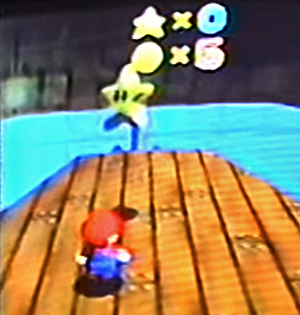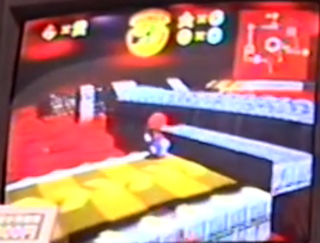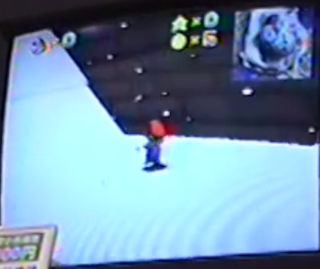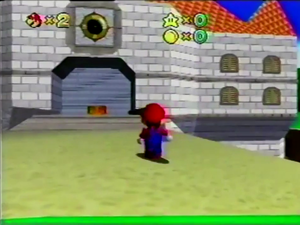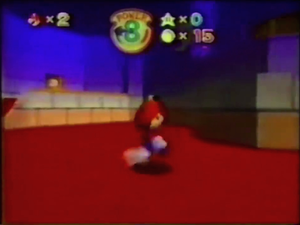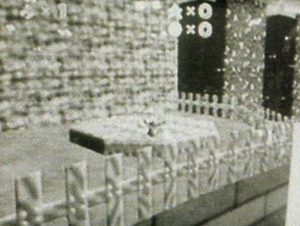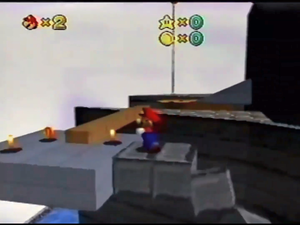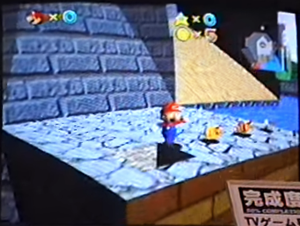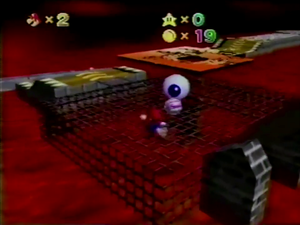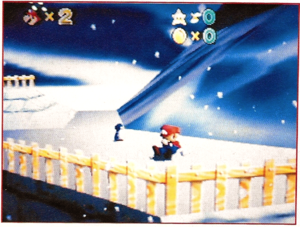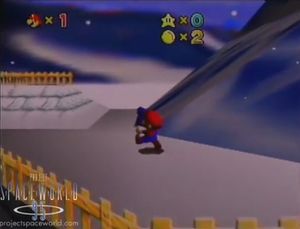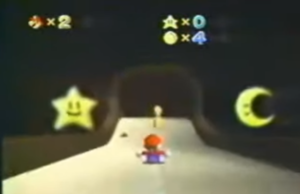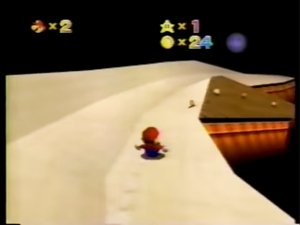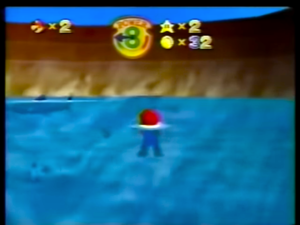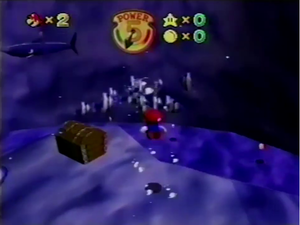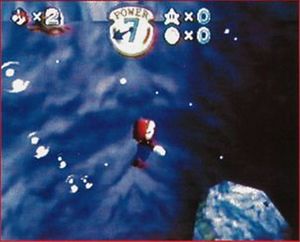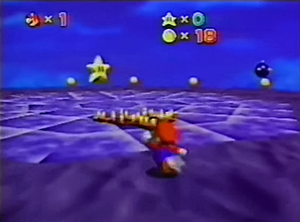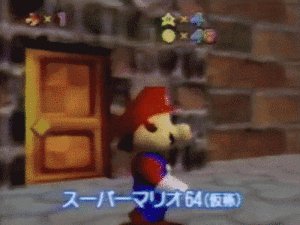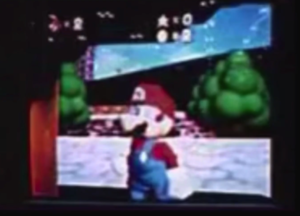Prerelease:Super Mario 64 (Nintendo 64)/Shoshinkai 1995 Demo
This is a sub-page of Prerelease:Super Mario 64 (Nintendo 64).
Information about Super Mario 64 first leaked in November 1995, and a playable build was presented days later as part of the world premiere of the Ultra 64 at Nintendo Shoshinkai. At this point, the basic controls had been implemented and the game was reportedly 50% finished, featuring 32 courses, although about 2% of mapping was complete. This build was compiled on November 15, 1995.
Being the first unveiling of Super Mario 64, these were the first assets seen by the general public. Graphics-wise, this version of the game has little in common with the final, but several levels and key gameplay features are set in stone. Players could control Mario freely in each stage and explore the castle, as well as use a stage select that used early names for levels (for example, Bowser in the Dark World was originally named "Koopa 1").
According to the developers, many players at Shoshinkai described Mario's 3D controls as "wobbly", "slippery", or "less responsive to the button inputs". Mario uses his old head/model found in the July 2020 Nintendo leak. He also starts out with 2 lives, with rumors stating that he could get an extra life if he gets 100 coins. According to Giles Goddard (programmer of this Mario's head), this build was just a snapshot of what was working at the time.
General Differences
| Prerelease | Final |
|---|---|
 |
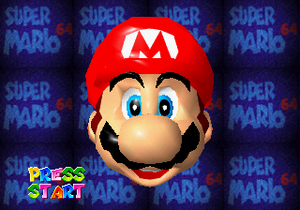 |
- The game starts with a simple blue Nintendo logo. This model was found in the July 2020 leak.
- The "Press Start" message on the title screen uses a more basic orange to yellow gradient and black outlined font.
- Shadows appear to be pixelated, rather than the smooth-edged ones in the final.
- The timing after selecting the option to exit out of the course is slower than the final.
- The "Press Start" message is positioned differently from the final.
- On the Game Over screen, the normal blue background seen on the title screen is used instead of the red variant seen in later builds of the game.
Gameplay and Physics
- When Mario enters a level, there is a trail of sparkles (like in the special triple jump you unlock for getting all 120 Stars) as he falls from the sky.
- Mario's triple jump causes him to twirl in the air (as if he'd jumped on a Spindrift) instead of doing a mid-air somersault. A similar ability would later be given to Luigi in Super Mario 64 DS, 8 years later.
- Mario does not pause in the air when he performs a ground pound. The camera does not pause or focus on Mario when he does a ground pound, either, unlike the final.
- Mario does not cover his head with his hands when he crouches.
- Mario, after taking large fall damage or respawning after dying in a painting world, visibly struggles to get up. This was changed in the final, possibly to keep the animation short (and less morbid); this can be seen here and here.
- While running, instead of slanting forwards towards the direction he is going, Mario runs completely straight.
- Mario doesn't jump when hit by fire.
- When Mario enters a level, the camera doesn't approach the painting.
- Mario seems to be almost always in the center of the camera.
- Mario blinks more often than in the final game.
- Mario only punches and kicks once each, instead of punching twice and kicking once.
- Mario gets up with his arms out after doing a dive jump.
- If Mario begins to move in any direction, he will turn to face said direction, instead of him taking a sharp turn like the final game.
- Mario's side flip gives him less height than the final, which is shown here in the B-Roll video. The animation is also different; its animation file name is JumpBack.
- When Mario steps away from sidestepping a wall, he will move at top speed.
- If the Nintendo 64 analog stick is pushed forward a little more, Mario will do a slow run, as shown here.
- When Mario is at a specific point of the platform in Whomp's Fortress, the animation abruptly stops during the punching animation (until you press the A button to jump). This glitch was fixed in the final game.
- Mario begins to pant when the Power Meter is at 4 life gauges, instead of 2.
- After Mario completes the level or fails to obtain the Star, the camera angle is different, which is shown here and here.
- No invincibility frames can be seen after Mario getting hurt.
- The cannon model is different and slightly unfinished, as shown here.
- The cannon cutscene has less refined camera movements, and the camera glitches out for a few frames while switching to the aiming view.
- The aiming reticule is missing.
- No sound effects are heard when Mario is shot from the cannon (other than Mario himself), the final game adds a cannonball and wind sound.
- No smoke trail can be seen behind Mario.
- At the peak of the cannon shot, Mario begins to fly as if he had the Wing Cap.
- The flight camera is different and does not follow Mario closely.
- When Mario bumps into geometry, no particles can be seen.
- If Mario is falling a great distance, he will scream for 3 seconds, as well as when he falls in the void.
- Mario can move around with the analog stick while in water, an ability that is not present in the final game.
Power Stars
- Power Stars are 2D animated sprites in this build. The Stars here were reused in the final for the silver and red stars that float around Mario's head in the title screen and for the design of the big sliding doors.
- The Stars are free floating in certain areas within the four available levels, without any puzzles to solve to obtain them (other than completing the slide in Cool Cool Mountain).
- Collecting a Star causes Mario to do the Star dance and exit the level, but no menus are pulled up once Mario has exited the painting. This is most likely a demo feature.
- When collecting a Star, the camera does not move away from Mario or approach his pose, staying the same as before collecting it.
- It also does not shake when Mario does the peace sign after obtaining the Star.
- When Mario collects a Star, a different dust animation plays twice.
Coins
Instead of a star insignia, the coins have a rectangular indentation consistent with prior Mario titles. The coin's color is also different, being a more orange-ish yellow compared to the final game's pure yellow.
HUD
| Prerelease | Final |
|---|---|
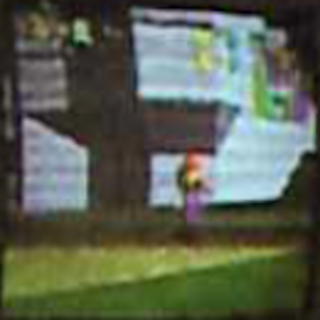 |
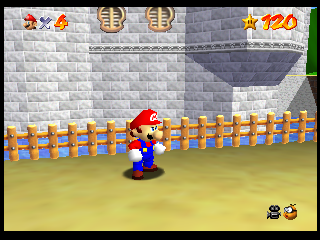 |
| Prerelease | Final |
|---|---|
 |
 |
| Minimap | A minimap is present in the upper-right corner, similar to the one from The Legend of Zelda: Ocarina of Time. It can be toggled on or off. The larger view of a level seen when paused replaced the minimap later on in development. The minimap idea was resurrected in the DS remake, which displays a map on the Touch Screen. The arrow shows where Mario/the player is navigating. This unused texture can be found here. The minimap is a bit transparent if you take a closer look (shown here, for example). A demonstration of toggling the minimap on and off is shown here. |
|---|---|
| Lives | Mario's head is a flat, stylized face in profile with a large nose. The detail on this icon is fairly simple, even though there is shading on Mario's nose connecting to the mustache. In the Shoshinkai demo, the number of lives is expressed with a single digit, while B-Roll footage from an earlier build would use two digits. Mario also started with 2 lives instead of 5. |
| Stars | Like Mario's head, the Star counter is also represented by a flat sprite, located at the center-right of the screen. The Star appears to have a simple yellow color with black outlines after B-Roll, which lacks outline. Its shape has a more roundish look than the final game's sharper look. |
| Coins | Located directly below the Star counter instead of beside it in the final. This placement makes room for the minimap. The Coin possesses a circular shape with an inner contour drawn on it, facing forward, and is colored in bright yellow, whereas the final version faces in a 3/4 view to the right, has a star-shaped insignia, and is colored in gold. |
| Font | A very standard bubble font with the numbers being different colors from light green to dark green. The Xs are small and yellow, as opposed to silver to white in the final game. |
| Health | Mario's health is displayed in a dial. His remaining health is also shown in numerical form, an idea later seen in early media of Super Mario Sunshine and the final release of Super Mario Galaxy. At this point, Mario's health regenerates automatically if he is not underwater. It's also a bit transparent, and sometimes you can see the scenery behind the bar. |
| Camera | There are no visible camera options in the HUD yet, but players can still use the C buttons to move the camera around along with the zooming. |
Audio Differences
To do:
|
| Description | Early | Final |
|---|---|---|
| Mario exclaiming "Yahaa!" | ||
| Mario grabbing on ledge | ||
| Mario taking fire damage | ||
| Mario taking damage | ||
| Mario getting a Star | ||
| Single Jump #1 / Mario exclaiming "Hooh!" | ||
| Single Jump #2 / Mario exclaiming "Ouh!" | ||
| Single Jump #3 / Mario exclaiming "Huah!" | ||
| Double Jump | ||
| Climb over ledge | ||
| Pickup item |
- Bowser's death sound originally played after he hit the bomb instead of when he hit the floor after hitting the bomb.
| Description | Early | Final |
|---|---|---|
| Bowser death | ||
| Bowser Growl | ||
| Bowser tail grab/bomb |
- The coin sound effect is a single sample, rather than a sequence like in the final game. It's also very different from the final. It was also found within the Star Fox 64 source code inside the Gigaleak, labelled as "coin.n.32.c4.aiff".
| Description | Early | Final |
|---|---|---|
| Coin Sound |
- The penguin walking sound is very different from the final version.
| Description | Early | Final |
|---|---|---|
| Title Theme |
- The title screen's music is faster, has different percussion, and uses some of Mario's voice clips.
- The music in Dire, Dire Docks uses a different instrument, taken from Digidesign SampleCell's Factory Library Disc 1, known there as Tine Piano C4. It can also be found in the Yoshi Touch & Go soundfont, labelled there as "Electric Piano".
- The Peach/Bowser portrait room plays a strange whistling melody that gets quieter as Mario approaches.
- The sound effects for doors opening, doors closing, and walking on shallow water are different. Notably, they were later used in The Legend of Zelda: Ocarina of Time.
| Description | Early | Final |
|---|---|---|
| Door Closing |
- The bird ambience is completely different compared to the final. The audio heard in the Castle Grounds footage of the Shoshinkai builds was likely from a sound effect library which was also used by HoMedics for their SoundSpa white noise machines made from 2004 to 2012 (e.g. the SoundSpa SS-4500), notably the Rainforest sample. It is unknown what exact sound it is and how much of the sample was used in the Shoshinkai build.
| Description | Early | Final |
|---|---|---|
| Bird Ambience |
- The music for Bob-omb Battlefield is played at a faster tempo. The drum samples used are different.
- The pitch bend in the main melody in the music for Lethal Lava Land doesn't hit as hard as in the final.
Level Changes
Castle Grounds
The player begins at the castle and is greeted with this text:
| Text | Translation |
|---|---|
ようこそ マリオワンダーランドへ ぼうけんずきのひとは めのまえのおしろへどうぞ |
Welcome to Mario Wonderland. If you're the adventurous sort, Pay a visit to the castle ahead. |
- The bridge has changed since the patent screenshots, adding guardrails and removing the stone pillars from the beginning. It still has a noticeable curve.
- The "cloud" above the castle appears to have been removed.
- The clock is still present above the entrance.
- The brick texture is noticeably simpler than it would be in later builds of the game.
- There is less wooden fencing surrounding the moat.
- Some trees are positioned differently.
- The flags on the castle are different and are completely static. It is hard to see in the footage but the flags feature Mario's HUD icon from this build.
- For some reason, the name "Mushroom Kingdom" was replaced with "Mario Wonderland".
- The castle archway for the entrance is shaped differently from the November 22, 1995 patent screenshots.
- The roof of the castle is trimmed off the bottom by extruding the wall.
- The shadow at the castle entrance has a different direction from the final build.
- The border of the entrance's door is missing, and so is the carpet.
- The brick floor on the entrance has a different texture consisting of pale pink and light green colors along with the gray colors.
- The waterfall is silent in this build.
Castle Interior
Upon entering the castle, this text appears:
| Text | Translation |
|---|---|
このおしろは てんじかい せんようです。 いろいろなせかいと つながっているので さきのとびらを ひらいて ぼうけんして ください。 |
This castle is exclusive to the show. It's connected to a variety of worlds, so open the doors ahead and get adventuring. |
- The walls are dark blue with a star-and-moon pattern on them.
- The stairs are simply made up of two platforms.
- A simple blue-to-orange color gradient decorates the bricks.
- Doors to stages display white numbers (1-4) instead of red numbers over stars. These numbers correspond to the level select and do not appear to be Star requirements yet. These textures can be found in the July 2020 Gigaleak.
- The room with the Bowser/Peach portrait has cracked stone walls, as opposed to brick castle walls in the final. An unknown high-pitched shrieking noise also appears to play in this room. The sound gets quieter as Mario approaches the portrait, indicating it may be Peach's shrieks.
- Level placement is not final: the entrance to Cool, Cool Mountain is in Door 3 on the left (where Bob-omb Battlefield is in the final), the entrance to Lethal Lava Land is in Door 2 on the bottom-right (where Whomp's Fortress would be later on), the entrance to Whomp's Fortress is in Door 1 right next to the entrance to Snow Slider level (where Cool, Cool Mountain is located in the final), and the second-floor door leads to the first fight with Bowser.
- Two platforms lead to the double door, and the rest of the walkway (to two other doors in the final, nonexistent themselves in this build) on the second floor does not exist yet.
- The paintings for Whomp's Fortress and Cool, Cool Mountain are not yet in their final forms.
- The basement is not present in this version, so the two doors on both sides of the stairs only lead to the courtyard's hallway.
- Every painting lacks the bottom part of the wall, meaning Mario can enter these paintings without jumping.
- The door model has a different handle color (an orangish-yellow, compared to the final version's pure yellow) and more polygons than the final.
Mountain (Whomp's Fortress)
| To do: Add what the textbox says when first entering this level. |
The layout is similar to the final version, but its appearance is fairly different.
- The path before the Piranha Plant at the top of the fortress is a red carpet.
- The background features an overcast sky.
- Many of the floors have circular stone textures. These textures can be found in the July 2020 leak.
- Thwomps have a darker blue color and angrier faces. They also have circular shadows. The model itself can be found in the July 2020 leak as well.
- Piranha Plants have completely different sound clips for biting. The animation for them sleeping also shows their teeth.
- Bomps have a different, more menacing design.
- The Star by the tower is not in a cage.
- The rotating platforms with red coins have not been implemented yet.
- The pole near the tower is closer to the Star and on the other side of the tower.
- The highest platform of the tower has a red marking on its top, which seems to be a question mark.
- The course's painting appears to show a picture of a field with two mushrooms instead of showing a picture of the course itself.
- Whomps have a completely different set of textures. This model is also found in the July 2020 leak.
- When Mario is riding Hoot, the camera does not rotate above him and Hoot moves up slowly.
- The tower's steps are triangular instead of rectangular. The triangular steps are still present in the final game, unused.
- Bullet Bills lack a shadow. These early Bullet Bills were found in the leak under the name of killer.sou.
- The cannon that shoots out Bullet Bills has different textures.
- Piranha Plants lack the dirt patches they reside on in the final.
- The fish appears to be jumping out of the water, perhaps as a kind of Easter egg, while Mario is going to the cannon. This behavior code can be seen here.
- There is one coin on each receding platform.
- The rotating wood plank has the markings as shown here.
- The railings right next to the cannon and the Blue Coin Switch area haven't been implemented yet.
- The wide Bomp has been added to this course.
- The cannon is positioned differently, and the Bob-omb Buddy next to it is missing.
- There are three coins instead of five in the launchable cannon area.
- There are three coins on the platform next to the thin bridge that were removed in the final.
- A ring of coins around the farthest flower bed isn't there.
- Butterflies near the flower bed don't exist yet.
Fire Bubble (Lethal Lava Land)
Arriving at this level, the text box reads:
| Text | Translation |
|---|---|
みぎにいくか ひだりに いくかは あなたのじゆう Cボタンをうまくつかって しんちょうに はやく! |
Left or right? It's all up to you. Make good use of the C buttons to move quickly but cautiously! |
This map is mostly similar to the final. Features are present such as Mr. I, the sliding puzzle, the collapsing and tilting platforms, and the volcano exterior.
- Mario starts on a path that is positioned to the right of the arch, instead of to the left.
- Bullies only have one spike atop their head instead of two horns, similar to the Chill Bully enemy in the final game. These early Bullies can be found in the July 2020 leak.
- There are no red coins on the puzzle.
- All of the rock structures with 1-Ups and coins are missing.
- There is no big Bully on the upmost platform. Instead, the Star and falling blocks are always present.
- The volcano interior hasn't been implemented yet. Attempting to enter the volcano causes Mario to get burned.
- There is no teleporter in the hole underneath Mr. I.
- A more menacing red-and-black skybox is used.
- Mr. I's bubble projectile has a different texture.
- There is no line of coins under the drawbridge.
- The lava isn't separate from the level model.
Snow Slider (Cool, Cool Mountain)
Level intro text:
| Text | Translation |
|---|---|
かぜを かんじたいひとは ひだりの あなに とびこ んでみるといいです。 すっごく きもちいいです |
If you want to feel the wind at your back, try jumping in the hole on the left. The sensation can't be beat. |
- Mario begins near the top of the mountain, which is made of ice and has a white stone texture on its side. The entrance for the slide is a hole atop a trapezoidal polygon with an igloo texture, similar to a cannon hole. One penguin is present.
- The lower part of the course is composed of a white brick texture, intersecting with a stone pyramid structure behind the penguin area. These textures are later replaced by the cabin and other wooden structures. The flat area of the level essentially resembles the final version, with penguins, an ice pool, and a floating Star in roughly the same location as the one in Little Penguin Lost.
- Mother Penguin and her baby, Tuxie, have different designs than they do in the final: their eyelids are droopy and their torsos are thinner. A total of three baby penguins can be seen in the demo. The Penguins' original design can be seen on a cereal box. These can also be found in the July 2020 leak.
- There don't seem to be any Mr. Blizzards or Spindrifts in this version.
- The music for Bob-omb Battlefield plays in the level. When Mario enters the slide, the music restarts, as both maps share the music.
- The slide area seen in this demo would later be repurposed for Tall, Tall Mountain in the retail release.
- The course's painting appears to show some snowy mountains instead of the Headless Snowman, a Mr. Blizzard, and a tree.
- While the slide area model has a similar layout to the final, there's an extra section after the first split which in the final game is just a dead end.
- Tuxie does not play the crying sound effect when being held.
- After Mario entered the hole leading to the slide area, there are guiding elements like in the following: START, the left arrow sign, and one more element that is barely visible in this video: JUMP. These yellow italic texts are removed in the final, even the sign texture. However, the collision of the sign is still there, as shown here.
- Mario doesn't race a penguin at all in the slide. This is interesting given that the Racing Penguin was added to the game early in development, as it is listed in stage/tag.cnf.
- In the slide area, the giant floating arrow that tells Mario to go right was missing.
Water Land (Dire, Dire Docks)
- A text box appears when Mario first falls into the water, but due to the footage that contains this cutting out the frames with actual text appearing, it is unknown what it says. Another reason why the textbox is not clear enough to see is this footage shown here. (This video shows the Shoshinkai 1995 tradeshow. You have to pay attention to the TV screen where the Water Land is. It's located right next to the Snow Slider and the B-Roll Promotional footage.) More evidence for the text box not being found is shown here (located at the bottom-left corner).
- The whirlpool hasn't been added yet.
- There is a small platform at the beginning of the level.
- Instead of sharp rocks, the background texture in the entry area is bricks layered on top of the lighter stone.
- The Water Mine object that goes unused in the final version is used throughout the level.
- The chests at the beginning of the level do nothing but release bubbles. This object behavior is present but unused in the final game. The chests have a different rotation every time you enter the level.
- Sushi is quite different. Its body is segmented and its textures are very different from the final game. The old textures and model can be found in the July 2020 leak.
- In place of the yellow arrow in the tunnel in the final game, there are two yellow triangles, and the tunnel is blue.
- The water appears to have a different texture, and it is colored cyan rather than the final's blue.
- The camera doesn't shake when Mario gets hit by an enemy or Water Mine. Shown here.
- There are a total of 5 coins on Bowser's Sub: two of them next to the climbable metal blocks, and three of the coins where the Power Star is.
- There are some Water Mines scattered underwater, which were removed from the final.
- Bowser's Submarine has the name "Koopa". This was later removed from the final and the texture is no longer present in the files.
Koopa 1 (Bowser in the Dark World)
As previously mentioned, Bowser in the Dark World was originally named "Koopa 1". Despite the level design being unchanged from the final build, there are still a few changes from the earlier build:
- The level starts in Bowser's arena, and after Mario enters it by the trapdoor, there is no Bowser cutscene.
- The skybox is completely different, featuring a dark blue sky with many clouds.
- Bowser's shadow disappears when Mario catches him by the tail.
- Bowser shrinks, then drops 20 coins and a Star when he is defeated, as opposed to shrinking and spinning, then dropping a Key.
- Bowser's model and textures have been finalized.
- The camera doesn't stay stuck in first-person mode after Mario is set on fire by Bowser.
- When Mario enters the trapdoor leading to this level, the warp icon has a circle form, as opposed to having a star-shaped one in the final.
- The camera doesn't freeze when Mario grabs Bowser by the tail; instead it moves as Bowser is rotated, similar to how the final game works.
- If Bowser was defeated by a bomb, his eyes remained open rather than being closed.
Courtyard
- Boos are present, but their face textures have an earlier design and do not match the final version. These textures can be found in the July 2020 leak.
- The fountain is textured differently, with dark bricks instead of light-gray stone. The brick texture of the fountain became the walls of the courtyard in the final game. There is no star statue in the fountain, either.
- The back of the castle uses a brown brick texture, instead of what is normally used for the castle exterior in the final game.
- The ground texture for each side of the fountain is dark brown.
- A Mr. I is present in this area, which was removed for the retail version.
- The large Boo containing the cage that leads to Big Boo's Haunt hasn't been implemented yet; it wouldn't be until 1996.
